

Document Type : Original Article
Authors
Soil and Water Resources Center, Directorate of Agricultural Research, Ministry of Science and Technology, Baghdad, Iraq
Abstract
Keywords
At the local, regional, and global levels, land degradation and food scarcity are major concerns. To mitigate their effects, integrated and suitable policies and activities must be implemented. In order to fulfil rising food demand, natural resource optimization should be maintained and land productivity should be raised. Iraq has a high percentage of desert regions, and a growing portion of the permanent pasture areas is prone to erosion due to decreasing plant cover. Furthermore, the existing farmland is being lost to other uses, notably in the areas of urbanization, industrialization, and transportation infrastructure, and this loss is more severe surrounding metropolitan centers.
Soil salinization, which results in excess of soluble salts in the root zone, is one of the primary land-degrading concerns affecting Soil fertility, stability, and biodiversity [2]. Sodic soils are characterized by the deposition of large amounts of sodium salt compared to other exchangeable cations [3]. Wind, rainfall, and the weathering of mother rock are the main sources of these salts in “primary” Soil salinization, whereas “secondary” Soil salinization occurs as a result of excessive salt buildup mainly due to human activities [4]. In general, salt-affected soils are found in arid and semiarid regions where evaporation dominates precipitation, concentrating salts in the root zone [2][5], resulting in unfavorable changes in the Soil’s physical, chemical, and biological activities [6].
The spread of salt-affected soils in central and southern Iraq, accompanied by the decrease in irrigation water and precipitation with the increase in drought in recent years, led to the deterioration of agricultural areas and their productivity in quantity and quality [1][7]. Therefore, it was necessary to use some of the appropriate applications to tackle these problems. In order to cultivate Salinity-affected soils with economic crops, it is necessary to reduce the harmful effect of salts on Soil and plants [8][9] and minimize excess salts in the root zone. Reclamation of these soils requires efficient, inexpensive amelioration strategies and proper management practices. Several Soil applications and treatments have been employed to achieve this goal, including Soil skimming, immersion, washing, and using chemical amendments such as gypsum, elemental sulfur, and sulfuric acid as direct and indirect sources of calcium in Soil solution. Some chemical treatments have also been applied to saline water to reduce the sodium adsorption ratio (SAR) in irrigation solution [10-15].
Biological reclamation is one of the most suitable applications for cultivating and rehabilitating salt-affected soils. Phytomanagement is one of the major methodologies used in biological reclamation. This technique is usually carried out by growing deep-rooted legume plants such as alfalfa and sesbania and then incorporating their residues into the topsoil layer [16-20], and many works proved the effectiveness of this method. [21] reported that rice husk could be used for the reclamation of saline-sodic soils by improving their physical conditions and fertility [22]. In another experiment, after three years of reclamation of alkaline Soil using gypsum and cultivation of carnal grass, a decrease in sodium and increased nitrogen uptake by 38% and organic carbon by 64% compared to the control was recorded in addition to the improved Soil biological, physical, and fertility properties [22]. [15] recommended Atriplex halimus as a phytoremediation crop to reclaim highly calcareous saline-sodic Soil. [23] indicated that fodder addition produced a high amount of carbon dioxide, which dissolved calcium carbonate, causing the release of calcium ions and replacing sodium ions from the clay complex. The benefits of combining organic and inorganic amendments in Salinity-affected soils’ reclamation were also investigated [24]. [25] pointed out that utilizing farmyard manure alone or in combination with inorganic nitrogen fertilizer on saline-sodic Soil has significant effects on wheat yield both under monoculture and in agroforestry systems.
In light of the previous debates, this research aims to compare the relative efficiency of incorporating plant residues on the properties of salt-affected soils.
A series of large-scale phytomanagement field trials were carried out in succession for 2012/2013, 2013/2014, and 2014/2015 seasons at Alatifiya Salinity Research Station, 35km south Baghdad, Agricultural Research Directorate, Ministry of Science and Technology in salt-affected Soil using saline groundwater from the same area with EC of 4.33 dS-1 and its sodium adsorption ratio is 6.63. The area of the experimental units was divided into plots of 500 m2 each. Treatments were repeated three times in a completely randomized block design (R.C.B.D.).
Soil samples (0-30 cm) were air-dried, ground, passed through a 2 mm sieve, and mixed well. The physical and chemical properties of the Soil before planting are presented in (Table 1). The analysis was carried out according to standard methods described by [26][27] using the instruments of a flame photometer, spectrophotometer, and atomic absorption meter (400P Analytica Jena).
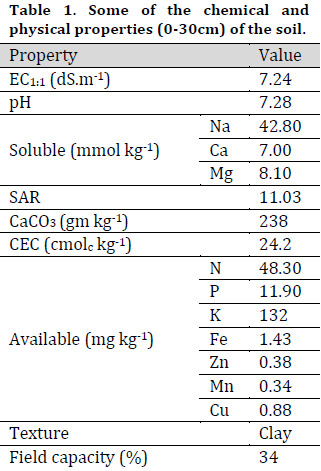
All experimental units were irrigated with well water (Table 2) for successive irrigations until the level of salts in the surface layer decreased to such an extent that plants were capable of growing.

The following phytomanagement treatments were carried out in the current research:
T1: Without cultivation (control).
T2: Cultivation of the Sesbania Plant (Sesbania aculeata).
T3: Cultivation of barley (Hordeum vulgare var. Sameer).
T4: Cultivation of the chard plant (Beta vulgaris).
T5: Mix cultivation of the chard plant and barley.
After plowing and settling, intermittent irrigation was given for all treatments. After germination, the plants were irrigated with well water as needed. Nitrogen and phosphorus fertilizers were added at the recommended rate. At maturity, the plants in T2 to T5 were harvested, and the grains and dry matter yield were recorded. The dry matter of plants residues about 4000 kg.h-1 of each treatment was air-dried, ground to pass through a 2.0 cm sieve, then incorporated with the upper 40 cm of soils. Urea was added at a rate of 40 kg.ha-1 to increase the rate of organic matter decomposition in the Soil while maintaining adequate Soil moisture within the field capacity limits for 8 to 10 weeks [20].
The same treatments were repeated in the 2013/2014 and 2014/2015 seasons. Soil samples (10 per replication × 3 replications × 5 treatment =150 samples for each season) were then taken from depth 0-30 cm. Soil electrical conductivity, pH, sodium adsorption ratio (SAR), organic matter content (OM%), available nutrients (N,P, and K), Soil aggregates stability, Soil bulk density, and Soil hydraulic conductivity analyses were carried out according to standard methods described by [26][27].
After the third season, barley was cultivated in all experimental blocks occupied by the previous treatments, and the yield was assessed.
Data were analyzed statistically using Genstat software package according to randomized complete block design (RCBD), with least significant difference (LSD 0.05) then the means were compared by Duncan’s Multiple Range Test.
The Soil at the experimental area was salt-affected with an electrical conductivity of 7.24 dS.m-1, pH value of 7.28, and sodium adsorption ratio (SAR) of 11.03 (Table 1). Also, The Soil was characterized by a clay texture, and that may be an encouraging factor for benefiting from the positive interaction of physical, chemical, and biological factors according to the biological reclamation [13][14][20][28]. The Irrigation water has a relatively medium salt content with an EC of 4.33, pH of 7.3, and sodium adsorption ratio (SAR) of 6.63 (Table 2), which is acceptable for most plants’ growth [10]. Therefore, it can be used to reduce salts level in salt-affected soils by cultivating Salinity-tolerant plants, economic crops, and trees [14][19][29].
The treatments of cultivation and incorporating plant dry matter in the Soil surface layer reduced the electrical conductivity of the Soil significantly compared to control treatment. The most pronounced decrease was observed in T5 (Mix cultivation of the chard plant and barley) (Table 3). The sodium adsorption ratio decreased in all cultivation treatments to less than 10, which is suitable for the growth of most plants [10], while control treatment recorded a SAR of 14.6. No relative differences were observed between treatments and control in terms of pH values. A noticeable improvement in organic matter level was observed in all cultivation treatments reaching 1.70% in the treatment of chard + barley compared to control (0.72%). This observation is due to the dry matter decomposition degree of chard + barley (T5) over time is higher than that of sesbania (T2) and barley (T3). Also, It was noted that the added amount of residues and their decomposition degree were reflected on the available nutrients content and improved Soil fertility compared to what they were before the experiments were performed (Table 1). Nutrient content reached 141, 20.5, and 226.4 mg. kg-1 Soil for nitrogen, phosphorous, and potassium, respectively, in the chard + barley treatment (T5). These findings refer to the importance of cultivation and incorporating the dry matter of plants in reducing the adverse effect of salt stress in Soil and plant and improving Soil fertility and further confirms previous results in this field [14][28]. Furthermore, the results highlight the role of sesbania, chard, and barley plants in causing noticeable chemical changes in soils through the release of organic carbon and roots exudates [30][31], changing Soil acidity [32], addition of organic matter and nutrients [13][20][33-36] and increasing decomposition of calcium carbonate in the presence of CO2 from the decomposition of organic matter and respiration of plant roots [8][37][38].
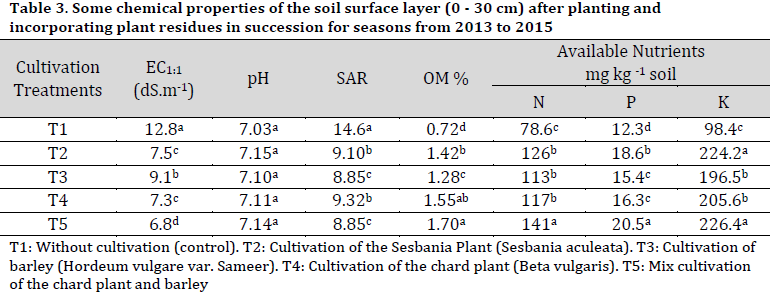
It was found that the cultivation and incorporation treatments resulted in a significant increase in the Soil aggregates stability, where the residues of chard + barley showed the highest segregate stability values (13.7%), followed by chard, sesbania, and barley with 11.4, 11.2, and 10.5%, respectively. The comparative control (without culture) gave the lowest stability rate (6.6%) (Fig. 1). The increase in the stability of Soil aggregates when adding plants residues is due to the role of organic matter in carbohydrates formation. The decomposition by microbial activity and the release of organic acids assist aggregates’ stability. For instance, fulvic acid and polysaccharides play an essential role in the presence of calcium and magnesium ions in increasing the stability of aggregates [39]. Additionally, organic matter encapsulates Soil particles and reduces the wetting speed [40]. The reason for varying aggregates stability values may be due to the different degrees of decomposition of each plant additive and the release of organic acids to the root zone of the Soil. These results are consistent with other findings [36][41-43] on the role of plant residues in improving Soil aggregates’ stability.

Results showed that the cultivation treatments and incorporating plant dry matter in the surface layer of the Soil resulted in a significant decrease in Soil bulk density. The chard + barley residues gave the lowest value of 1.14 g cm-3 compared to control (1.36 g cm-3).
It is noted that the treatment of chard + barley significantly outperformed all the treatments in this attribute (Fig. 2). The lower Soil bulk density observed when adding organic residues is due to the role of organic matter in improving Soil structure and increasing the Soil aggregates’ stability. These results are consistent with [43][44] who found a decreased Soil bulk density with the addition of different levels of organic matter.
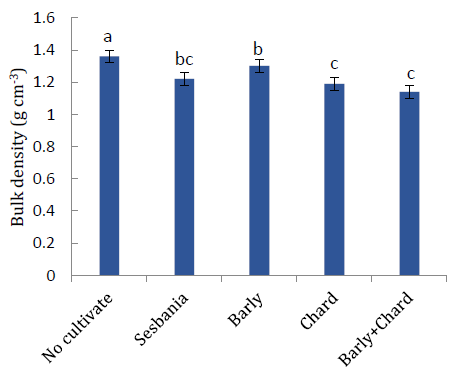
The cultivation treatments and incorporation of the dry matter in the topsoil layer resulted in a significant increase in the Soil hydraulic conductivity. The lowest conductivity value was recorded by control (0.70 cm.h-1), while the chard, sesbania, and barley residues gave 1.47, 1.21, and 1.03 cm.h-1, respectively. It is noted that the treatment of chard + barley significantly exceeded all treatments in this characteristic (2.10 cm.h-1) (Fig. 3). The reason for the increase in water conductivity of the Soil when adding organic residues of cultivation plants is due to the role of organic matter in improving Soil structure, reducing bulk density, and increasing the stability of Soil aggregates, which leads to the increase of capillary pipes conducting water, expand their diameters and regularity reduce sprains. This is consistent with the findings of [43] that crop residues added to agricultural soils have a positive effect on their water properties as well as improving most of the physical characteristics of the Soil.
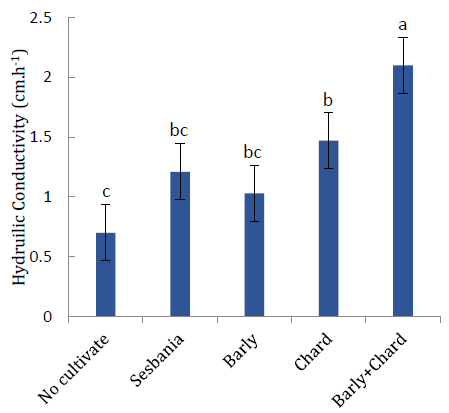
It was found that the consecutive phytomanagement treatments significantly affected the barley grain yield compared to the control treatment. It is noted that the treatment of mixed agriculture (barley + chard) has significantly outperformed all the treatments followed by the treatment of chard, sesbania, and barley (Table 5). This may be due to the different quality of the residues added to the surface layer of the Soil depending on the treatment as there is inevitably a variation in the nature of the vegetative total of each plant, as well as the level of decomposition of the dry matter of each plant overtime during the three seasons. Additionally, the contributions to reducing the level of salts and increase nutrients availability to the plant, such as nitrogen, phosphorus, and potassium, differed between treatments reflected on improving of growth and yield of barley in different proportions. This is confirmed by the results of [14][20] with Barley and [19][28] with rice.
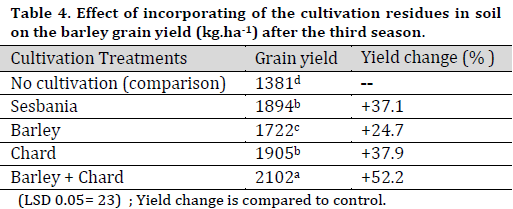
The used cultivation treatments improved Soil organic matter level under Salinity conditions after three cultivation seasons; this improvement varied according to the cultivated plant. The treatment of mixed agriculture (barley + chard) has significantly outperformed other treatments in improving some of the Soil chemical and physical properties and the grain yield of barley after three seasons of cultivation.
Based on the above, it can be recommended that:
Conflict of interest statement
The authors declared no conflict of interest.
Funding statement
The authors declared that no funding was received in relation to this manuscript.
Data availability statement
The authors declared that all related data are included in the article.